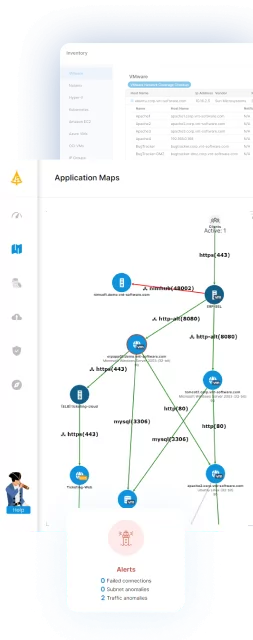What Is East-West Traffic?
East-west traffic, in the context of networking, refers to data communication that occurs between devices within the same network or data center, rather than traffic that enters or leaves the network (north-south traffic). This internal communication is crucial for many applications, particularly in modern architectures like microservices and distributed systems.
Unlike north-south traffic, which flows in and out of the data center or between end users and applications, east-west traffic remains internal, supporting core business functions as different components interact and exchange data. This type of traffic has become significant with the rise of distributed applications, virtualization, and multi-tier architectures.
Modern workflows, especially microservices and containerized deployments, can generate terabytes of internal traffic daily. Without proper segmentation and monitoring, this internal communication can become a hotspot for security vulnerabilities and potential lateral movement by attackers once inside the network perimeter.
This is part of a series of articles about network security
Table of Contents
Toggle- What Is East-West Traffic?
- How Does East-West Traffic Security Work?
- East-West Traffic vs. North-South Traffic
- Tips from the Expert
- Examples of East-West Traffic
- Challenges Associated with East-West Traffic
- Best Practices for East-West Traffic Management
- Gaining Visibility Over East-West Traffic with Faddom
How Does East-West Traffic Security Work?
East-west traffic security focuses on controlling and monitoring the communication between systems, services, or virtual machines within the same data center or cloud environment. Since this traffic occurs internally, it does not benefit from traditional perimeter security measures, which protect the boundary between internal systems and external networks.
To secure east-west traffic, the focus shifts to monitoring and analyzing traffic patterns, ensuring that only authorized interactions occur between systems within the environment. By continuously observing the flow of data between components, any suspicious or unauthorized activity can be detected early, limiting the potential for security breaches or lateral movement by attackers.
In practice, this involves inspecting the data packets exchanged between systems, enforcing policies that control which systems can communicate with one another, and validating that requests for internal communication are legitimate. This process helps ensure that only trusted and authorized traffic flows within the network, mitigating the risk of internal threats or compromised systems spreading across the environment.
East-West Traffic vs. North-South Traffic
East-west traffic and north-south traffic refer to different types of data flow within a network, each with distinct characteristics and security considerations.
East-west traffic occurs within the boundaries of a data center or cloud environment. It represents the communication between systems, services, or virtual machines that reside on the same network. This type of traffic typically supports the internal functioning of applications, microservices, databases, and other components that interact to deliver core business operations. It is more prevalent in modern distributed architectures, such as cloud environments and microservices deployments, where applications operate in a decentralized manner.
North-south traffic flows between the internal network (such as a data center or cloud environment) and external networks, typically the internet or end users. This includes data entering or leaving the environment, such as user requests for web services or access to applications from outside the network. North-south traffic is essential for supporting public-facing services and interactions with external clients or other systems.

Lanir specializes in founding new tech companies for Enterprise Software: Assemble and nurture a great team, Early stage funding to growth late stage, One design partner to hundreds of enterprise customers, MVP to Enterprise grade product, Low level kernel engineering to AI/ML and BigData, One advisory board to a long list of shareholders and board members of the worlds largest VCs
Tips from the Expert
In my experience, here are tips that can help you better secure and manage east-west traffic:
- Map application dependencies dynamically: Static mapping is insufficient in dynamic environments. Use tools that offer real-time application dependency mapping to understand actual traffic flows and avoid misconfigured segmentation or blocked services.
- Establish east-west honeypots: Deploy internal deception systems to lure attackers navigating laterally. These honeypots are invaluable in early breach detection and revealing lateral movement patterns without interfering with legitimate services.
- Use behavior-based traffic baselining: Implement machine learning or anomaly detection systems to establish what “normal” traffic looks like between systems. Alert on deviations, such as unusual port usage, volume spikes, or time-of-day anomalies.
- Integrate east-west telemetry into SIEM: Feed internal traffic data into the SIEM platform. Correlating east-west patterns with external threat intelligence and endpoint data enhances context-aware security decisions.
- Segment by application tiers, not just network zones: Traditional VLAN or subnet segmentation is too coarse. Group workloads based on application functionality—like frontend, backend, and database tiers—so policies align with actual business logic.
Examples of East-West Traffic
Server-to-Server Communication
In a data center hosting multiple application servers, these systems frequently exchange data to balance workloads, replicate sessions, or process user requests. For example, when an eCommerce platform runs across several servers to handle high traffic, requests and session data may flow between these servers to ensure performance. Behind the scenes, this activity generates large volumes of internal network traffic that never leaves the data center boundaries.
Effective security for server-to-server communication requires monitoring the content and patterns of these conversations. Without proper controls, an attacker who compromises one server could move laterally to others within the same environment. Firewalls, application allowlisting, and network segmentation act as key countermeasures.
Database Replication
Database replication involves synchronizing data across multiple database instances, often for redundancy, high availability, or disaster recovery. This process creates continuous east-west traffic as changes in one database instance are shared with others within the same site or across different availability zones.
In financial services, healthcare, or high-transaction environments, database replication can account for a significant portion of intra-data center traffic. Attackers targeting unencrypted replication can intercept or manipulate data streams. Organizations should enforce strict access controls, encrypt traffic using TLS, and monitor replication processes to detect anomalies or unauthorized synchronization efforts.
Microservices Interactions
Microservices architectures break down applications into small, independent services that communicate over the network using APIs or messaging protocols. The traffic generated as microservices coordinate during application execution forms a dense mesh of east-west communication within the data center.
For example, ordering, payment, and inventory services in an online retail application may exchange messages hundreds of times per transaction. Securing microservices interactions involves application-level authentication, service mesh frameworks, and fine-grained authorization policies to ensure that only legitimate service calls are allowed.
File Transfers
Internal file transfers, such as backups, log shipping, or routine movement of large data sets, generate substantial east-west traffic. A common example is when nightly backups are sent from application servers to internal storage clusters or disaster recovery sites within the same data center. In other cases, system administrators may routinely transfer configuration files or patches between systems inside private infrastructure boundaries.
Security risks arise if these internal file transfers are not properly authenticated or encrypted. Attackers gaining internal access might intercept, alter, or exfiltrate sensitive files. To counter these risks, organizations need to implement endpoint authentication, use encrypted protocols like SFTP, and maintain strict auditing of internal file transfer activities.
Challenges Associated with East-West Traffic
Here are some of the main aspects of east-west traffic that can make it challenging to manage.
Visibility and Monitoring
Gaining visibility into east-west traffic is a significant challenge, particularly in environments with large numbers of virtual machines, containers, or microservices. Traditional monitoring tools often focus on north-south traffic at the perimeter, missing the detailed activity that occurs internally.
As a result, organizations may have blind spots that attackers could exploit to move laterally without detection. The complexity is compounded by the sheer volume and dynamic nature of internal communications, making it hard to distinguish normal behavior from potentially malicious activities.
Security Risks
East-west traffic poses unique security risks because traditional perimeter security measures are often ineffective once an adversary has breached internal defenses. Attackers who obtain initial access can exploit unrestricted lateral communication channels to infect other servers, escalate privileges, or exfiltrate valuable data.
These lateral attacks are particularly dangerous as they may bypass established controls focused solely on north-south solutions, such as perimeter firewalls or intrusion prevention systems.
Network Congestion
As application architectures grow more decentralized and data-intensive, east-west traffic volumes can cause significant network congestion within data centers. High-velocity data exchanges between servers, storage, and applications compete for limited bandwidth, leading to latency, packet loss, and performance bottlenecks.
This hinders application responsiveness and also degrades the overall user experience, especially in environments where real-time processing or transaction throughput is critical.
Best Practices for East-West Traffic Management
Organizations should consider these practices to ensure smooth east-west traffic across their applications.
1. Leverage Microsegmentation
Microsegmentation is a strategy that divides a network into smaller, isolated segments, creating distinct security boundaries within the same physical or cloud infrastructure. By segmenting the network at a granular level, organizations can enforce strict communication policies that control which systems or services are allowed to communicate with each other.
This approach limits the lateral movement of attackers within the network. If one system is compromised, the attacker’s ability to spread across the entire environment is drastically reduced because the segmented network restricts their reach. Microsegmentation also allows for visibility into traffic patterns within each segment.
Microsegmentation can be implemented using software-defined networking (SDN) or network virtualization tools that dynamically adjust traffic flow based on policies. Administrators can set policies that specify what kind of traffic is allowed between virtual machines, containers, or applications. For example, a database server may only be allowed to communicate with specified web servers.
2. Implement Strong Access Controls
Effective access control ensures that only authorized systems, users, or services can interact with each other. The principle of least privilege should be applied, meaning that systems or services are only granted the minimal access necessary for their function. This reduces the surface area for potential attacks and limits the damage from compromised components.
Access control can be implemented using several methods, including:
- Role-based access control (RBAC): Users or systems are assigned specific roles that define what they can access or interact with. For example, a web server may only be allowed to communicate with certain databases, while a data analytics server may not have access to sensitive customer data.
- Attribute-based access control (ABAC): Policies are based on attributes such as user identity, system role, location, or time of access. This adds flexibility and can be adjusted dynamically based on contextual factors.
- Identity and access management (IAM): Solutions like IAM enforce authentication and authorization policies to ensure that only authorized entities can communicate within the environment. Multi-factor authentication (MFA) can add an extra layer of security to these access controls.
Access controls should be continuously reviewed and updated to ensure that they reflect current security policies and organizational changes. Automated tools can help manage access control policies and detect anomalies in real time, alerting administrators to potential violations.
3. Use Encrypted Communication Channels
Even if an attacker manages to intercept traffic, encryption ensures that the data remains unreadable without the proper decryption key. This is particularly important when sensitive or confidential information is being exchanged, such as personally identifiable information (PII), financial data, or proprietary business intelligence.
To implement encryption for east-west traffic, organizations can use protocols like:
- Transport layer security (TLS): TLS is widely used to encrypt communications between web servers, databases, and other applications. This protocol ensures that all traffic between systems is encrypted, including sensitive information such as login credentials and session tokens.
- IPsec (internet protocol security): IPsec can be used to secure traffic at the IP layer, providing encryption for network-level communication between systems or virtual machines. This is useful for protecting internal data as it moves between data centers or between cloud environments.
- SSL/TLS mutual authentication: To further improve security, both parties in the communication (client and server) can authenticate each other using certificates, ensuring that only trusted systems can establish communication.
By encrypting internal traffic, organizations protect against threats like man-in-the-middle attacks, packet sniffing, and data tampering. Encrypted communication channels also help organizations comply with data protection regulations, such as GDPR or HIPAA, which require organizations to protect sensitive data at all stages of transmission.
4. Adopt Automated Configuration Management
With the complexity of modern data centers and cloud environments, manually configuring each system can lead to errors, misconfigurations, or vulnerabilities that attackers can exploit. Automated tools can help mitigate these risks by ensuring that each system adheres to the correct security settings, minimizing the risk of human error.
Key practices for automated configuration management include:
- Centralized policy management: Security configurations are defined and managed centrally, ensuring consistency across all systems. Any changes to configuration settings are automatically propagated to all relevant systems.
- Automated patch management: Patches and updates are deployed automatically to fix vulnerabilities in both the operating system and application layers, reducing the window of opportunity for attackers to exploit known vulnerabilities.
- Configuration drift detection: Over time, systems may deviate from their intended configuration due to updates, user changes, or other factors. Automated tools continuously check for these changes and alert administrators if configurations become inconsistent or insecure.
- Version control: All configuration changes are tracked and logged, enabling administrators to roll back to previous configurations in case of misconfiguration or security incidents.
By automating these processes, organizations can improve their overall security posture, reduce configuration errors, and ensure that security settings are uniformly applied to all systems, especially those handling sensitive east-west traffic.
5. Regular Network Audits and Penetration Tests
Regular network audits and penetration tests are essential for assessing the security of east-west traffic. These proactive measures help identify vulnerabilities that could be exploited by attackers and ensure that the network’s security controls are effective.
- Network audits: Audits involve systematically reviewing network configurations, traffic flows, and security settings to ensure they align with best practices and security policies. Network audits help identify misconfigurations, excessive privileges, and other weaknesses in the internal communication flow that could be targeted by attackers.
- Penetration tests: Penetration testing simulates real-world attacks to identify vulnerabilities and assess the effectiveness of existing security measures. Ethical hackers attempt to exploit weaknesses in the network, such as misconfigured access controls or unsecured services, to determine how deep an attacker could go if they breached the perimeter. These tests help uncover areas where the internal network may be exposed to lateral movement or data exfiltration.
Both network audits and penetration tests should be conducted regularly to account for changes in the network, the introduction of new services or applications, and the evolving tactics of cyber attackers. Automated tools can assist in ongoing monitoring, but human oversight is critical to understanding the broader security context and addressing complex vulnerabilities.
Gaining Visibility Over East-West Traffic with Faddom
Effectively managing east-west traffic requires clear visibility into how applications and servers communicate within your data center or cloud environment. Traditional monitoring tools often focus only on the perimeter, leaving blind spots within your infrastructure. Faddom addresses this issue with dynamic, agentless application dependency mapping that reveals every internal connection in real-time. This visibility enables security teams to detect unauthorized lateral movement, understand microservice interactions, and confidently enforce microsegmentation policies.
With Faddom, you can eliminate the guesswork from securing internal traffic. Our lightweight deployment provides clarity across hybrid environments in under 60 minutes, allowing IT teams to reduce risk, prevent hidden vulnerabilities, and optimize performance.
Book a demo today to see how Faddom can help you gain complete control over your east-west traffic!







